Recent Progress on Moisture Absorption Aging of Plant Fiber Reinforced Polymer Composites
Abstract
:1. Introduction
2. Water Absorption Mechanism
3. Water Absorption Behavior of Plant Fibers and Substrates
4. Effect of Hygroscopic Properties on Mechanical Properties of Composite Materials
5. Methods for Reducing the Water Absorption of Composite Materials
5.1. Chemical Methods
5.1.1. Alkali Treatment
5.1.2. Benzoylation
5.1.3. Silane Coupling Agent
5.1.4. Maleic Anhydride
5.1.5. Acetylation
5.1.6. Sodium Bicarbonate
5.2. Fiber Hybrids
5.2.1. Plant Fiber Hybrid
5.2.2. Synthetic Fiber Hybrid
5.3. Polymer Coating
5.4. Nanofillers
6. Conclusions
- (1)
- The water absorption of composite materials is affected by various parameters, such as the selection of polymers and plant fibers, the mass fraction of plant fibers, fiber modification methods, water absorption time, and environmental humidity. However, the main parameters are the selection of plant fibers, fiber mass fraction, and water absorption time. It was concluded that plant fiber and synthetic fiber hybrid, polymer coating, and tile process coating have significantly improved the water resistance of composite materials, based on the current research.
- (2)
- The modification of the plant fiber polymer interface has always been a hot topic in the research on composite materials. Currently, there are many modification methods emerging, but the key technology for modifying plant fiber by polymer coating and Walli process coating still lags behind that in foreign countries. In addition, using these methods alone to treat plant fiber and its composite material’s water resistance cannot achieve the optimal state, Therefore, mixing polymer coating and Vary process coating with other physical/chemical methods for modification is an important research direction for improving the water resistance of plant fiber composite materials in the future.
- (3)
- Whether plant fiber composite materials can replace synthetic fiber composite materials in certain fields mainly depends on the changes in mechanical properties of plant fiber composite materials after water absorption. The authors believe that modifying plant fibers through various physical/chemical methods and different preparation processes can improve the mechanical properties of composite materials, but it cannot improve the moisture absorption properties of composite materials any further, ultimately leading to poor mechanical properties after water absorption. Therefore, it is necessary to develop a universal and low-cost technology to jointly improve the mechanical properties and water resistance of composite materials.
- (4)
- The researchers have developed water molecule diffusion models to study the water absorption behavior of composite materials and explain the water resistance performance of different composite materials. Therefore, developing different models to study the water resistance performance of composite materials is also an important direction for research in the future. By developing different water absorption models to express the water absorption behavior of plant fiber composite materials and continuously promote the development of new molding and modification processes, efforts will be made to achieve the development of high intelligence and low production costs, thereby promoting the widespread application of plant fiber composite materials.
Author Contributions
Funding
Informed Consent Statement
Data Availability Statement
Conflicts of Interest
References
- Athijayamani, A.; Thiruchitrambalam, M.; Natarajan, U.; Pazhanivel, B. Effect of moisture absorption on the mechanical properties of randomly oriented natural fibers/polyester hybrid composite. Mater. Sci. Eng. A 2009, 517, 344–353. [Google Scholar] [CrossRef]
- Musthaq, M.A.; Dhakal, H.N.; Zhang, Z.; Barouni, A.; Zahari, R. The Effect of Various Environmental Conditions on the Impact Damage Behaviour of Natural-Fibre-Reinforced Composites (NFRCs)—A Critical Review. Polymers 2023, 15, 1229. [Google Scholar] [CrossRef] [PubMed]
- Leman, A.Z.; Sapuan, A.S.M.; Saifol, A.A.M.; Maleque, B.M.A.; Ahmad, M.M.H.M. Moisture absorption behavior of sugar palm fiber reinforced epoxy composites—ScienceDirect. Mater. Des. 2008, 29, 1666–1670. [Google Scholar] [CrossRef]
- Bessadok, A.; Marais, S.; Gouanve, F.; Colasse, L.; Zimmerlin, I.; Roudesli, S.; Metayer, M. Effect of chemical treatments of Alfa (Stipatenacissima) fibres on water-sorption properties. Compos. Sci. Technol. 2007, 67, 685–697. [Google Scholar] [CrossRef]
- Gupta, M.K.; Gond, R.K.; Bharti, A. Effects of treatments on the properties of polyester based hemp composite. Indian J. Fibre Text. 2018, 43, 313–319. [Google Scholar]
- Xie, Y.; Hill, C.A.S.; Xiao, Z.; Milite, H.; Mai, C. Silane coupling agents used for natural fibre/polymer composites: A review. Compos. Part. A Appl. S 2010, 41, 806–819. [Google Scholar] [CrossRef]
- Lu, J.Z.; Wu, Q.; McNabb, H.S. Chemical coupling in wood fibre and polymer composites: A review of coupling agents and treatments. Wood Fiber Sci. 2007, 32, 88–104. [Google Scholar]
- Rodriguez, E.; Francucci, G. PHB coating on jute fibers and its effect on natural fibre composites performance. J. Compos. Mater. 2016, 50, 2047–2058. [Google Scholar] [CrossRef]
- Gupta, M.K.S.R. PLA coated sisal fibre-reinforced polyester composite: Water absorption, static and dynamic mechanical properties. J. Compos. Mater. 2019, 53, 65–72. [Google Scholar] [CrossRef]
- Gupta, M.K. Investigations on jute fibre-reinforced polyester composites: Effect of alkali treatment and poly (lactic acid) coating. J. Ind. Text. 2020, 49, 923–942. [Google Scholar] [CrossRef]
- Mokhothu, T.H.; John, M.J. Bio-based coatings for reducing water sorption in natural fibre reinforced composites. Sci. Rep. UK 2017, 7, 13335. [Google Scholar] [CrossRef]
- Akil, H.M.; Santulli, C.; Sarasini, F.; Tirillo, J.; Valente, T. Environmental effects on the mechanical behaviour of pultruded jute/glass fibre-reinforced polyester hybrid composites. Compos. Sci. Technol. 2014, 94, 62–70. [Google Scholar] [CrossRef]
- Gupta, M.K.; Srivastava, R.K. Mechanical, thermal and water absorption properties of hybrid sisal/jute fibre reinforced polymer composite. Indian J. Eng. Mater. S 2016, 23, 231–238. [Google Scholar]
- Gupta, M.K.; Deep, V. Effect of water absorption and stacking sequences on properties of hybrid sisal/glass fibre reinforced polyester composite. Proc. Inst. Mech. Eng. Part L J. Mater. Des. Applw. 2019, 233, 2045–2056. [Google Scholar] [CrossRef]
- Thwe, M.M.; Liao, K. Effects of environmental aging on the mechanical properties of bamboo–glass fibre reinforced polymer matrix hybrid composites. Compos. Part A Appl. Sci. Manuf. 2002, 33, 43–52. [Google Scholar] [CrossRef]
- Pothan, L.A.; Thomas, S. Effect of hybridization and chemical modification on the water-absorption behavior of banana fibre-reinforced polyester composites. J. Appl. Polym. Sci. 2004, 91, 3856–3865. [Google Scholar] [CrossRef]
- Mishra, S.; Mohanty, A.; Drzal, L.; Misra, M.; Parija, S.; Nayak, S.K.; Tripathy, S.S. Studies on mechanical performance of biofibre/glass reinforced polyester hybrid composites. Compos. Sci. Technol. 2003, 63, 1377–1385. [Google Scholar] [CrossRef]
- Khan, M.Z.; Srivastava, S.K.; Gupta, M. Water absorption and its effect on mechanical properties of sisal composite. Mater. Res. Express 2018, 6, 105305. [Google Scholar] [CrossRef]
- Sahu, P.; Gupta, M.K. Lowering in Water Absorption Capacity and Mechanical Degradation of Sisal/Epoxy Composite by Sodium Bicarbonate Treatment and PLA Coating. Polym. Compos. 2019, 41, 668–681. [Google Scholar] [CrossRef]
- Jarukumjorn, K.; Suppakarn, N. Effect of glass fibre hybridization on properties of sisal fibre–polypropylene composites. Compos. Part B Eng. 2009, 40, 623–627. [Google Scholar] [CrossRef]
- Azwa, Z.N.; Yousif, B.F.; Manalo, A.C.; Karunasens, W. A review on the degradability of polymeric composites based on natural fibres. Mater. Des. 2013, 47, 424–442. [Google Scholar] [CrossRef]
- Dhakal, H.N.; Zhang, Z.Y.; Richardson, M.O.W. Effect of water absorption on the mechanical properties of hemp fibre reinforced unsaturated polyester composites. Compos. Sci. Technol. 2007, 67, 1674–1683. [Google Scholar] [CrossRef]
- Sen, I.; Aral, A.; Seki, Y.; Sarikanat, M.; Sever, K. Variations of mechanical properties of jute/polyester composite aged in various media. J. Compos. Mater. 2012, 46, 2219–2225. [Google Scholar] [CrossRef]
- Duigou, A.L.; Davies, P.; Baley, C. Seawater ageing of flax/poly(lactic acid) bio-Composites. Polym. Degrad. Stabil. 2009, 94, 1151–1162. [Google Scholar] [CrossRef]
- Panthapulakkal, S.; Sain, M. Studies on the water absorption properties of short hemp–glass fibre hybrid polypropylene composites. J. Compos. Mater. 2007, 41, 1871–1883. [Google Scholar] [CrossRef]
- ASTM D570; Standard Test Method for Water Absorption of Plastics. ASTM: West Conshohocken, PA, USA, 2022.
- Saxena, M.; Gupta, M.K. Mechanical, thermal, and water absorption properties of hybrid wood composites. Proc. Inst. Mech. Eng. Part L J. Mater. Des. Appl. 2018, 233, 1914–1922. [Google Scholar] [CrossRef]
- Wang, J.; Wu, W.; Lin, Z. Kinetics and thermodynamics of the water sorption of 2-hydroxyethyl methacrylate/styrene copolymer hydrogels. J. Appl. Polym. Sci. 2008, 109, 3018–3023. [Google Scholar] [CrossRef]
- Mohan, T.P.; Kanny, K. Water barrier properties of nanoclay filled sisal fibre reinforced epoxy composites. Compos. Part A Appl. Sci. Manuf. 2011, 42, 385–393. [Google Scholar] [CrossRef]
- Reddy, C.R.; Sardashti, A.P.; Simon, L.C. Preparation and characterization of polypropylene–wheat straw–clay composites. Compos. Sci. Technol. 2010, 70, 1674–1680. [Google Scholar] [CrossRef]
- Munoz, E.; García-Manrique, J.A. Water Absorption Behaviour and Its Effect on the Mechanical Properties of Flax Fibre Reinforced Bioepoxy Composites. Int. J. Polym. Sci. 2015, 2015, 390275. [Google Scholar] [CrossRef]
- Joseph, P.V.; Rabello, M.S.; Mattoso, L.; Joseph, K.; Thomas, S. Environmental effects on the degradation behaviour of sisal fibre reinforced polypropylene composites. Compos. Sci. Technol. 2002, 62, 1357–1372. [Google Scholar] [CrossRef]
- Munday, D.L.; Cox, P.J. Compressed xanthan and karaya gum matrices: Hydration, erosion and drug release mechanisms. Int. J. Pharm. 2000, 203, 179–192. [Google Scholar] [CrossRef] [PubMed]
- Ku, H.; Wang, H.; Pattarachaiyakoop, N.; Trada, M. A review on the tensile properties of natural fiber reinforced polymer composites. Compos. Part B Eng. 2011, 42, 856–873. [Google Scholar] [CrossRef]
- Zahari, W.Z.W.; Badri, R.N.R.L.; Ardyananta, H.; Kurniawan, D.; Nor, F.M. Mechanical Properties and Water Absorption Behavior of Polypropylene/Ijuk Fiber Composite by Using Silane Treatment. Procedia Manuf. 2015, 2, 573–578. [Google Scholar] [CrossRef]
- Maslinda, A.B.; Majid, M.A.; Ridzuan, M.; Afendi, M.; Gibson, A. Effect of water absorption on the mechanical properties of hybrid interwoven cellulosic-cellulosic fibre reinforced epoxy composites. Compos. Struct. 2017, 167, 227–237. [Google Scholar] [CrossRef]
- Sahu, P.; Gupta, M.K. Water absorption behavior of cellulosic fibre polymer composites: A review on its effects and remedies. J. Ind. Text. 2020, 51, 7480S–7512S. [Google Scholar] [CrossRef]
- Shahzad, A. Effects of water absorption on mechanical properties of hemp fibre com-Posites. Polym. Compos. 2012, 33, 120–128. [Google Scholar] [CrossRef]
- Chow, C.; Xing, X.S.; Li, R. Moisture absorption studies of sisal fibre reinforced polypropylene composites. Compos. Sci. Technol. 2007, 67, 306–313. [Google Scholar] [CrossRef]
- Hu, R.H.; Sun, M.Y.; Lim, J.K. Moisture absorption, tensile strength and microstructure evolution of short jute fiber/polylactide composite in hygrothermal environment. Mater. Des. 2010, 31, 3167–3173. [Google Scholar] [CrossRef]
- Moudood, A.; Rahman, A.; Khanlou, H.M.; Hall, W.; Francucci, G. Environmental effects on the durability and the mechanical performance of flax fiber/bio-epoxy composites. Compos. Part B Eng. 2019, 171, 284–293. [Google Scholar] [CrossRef]
- Das, S. Mechanical and water swelling properties of waste paper reinforced unsaturated polyester composites. Constr. Build. Mater. 2017, 138, 469–478. [Google Scholar] [CrossRef]
- Ridzuan, M.; Majid, M.; Afendi, M.; Afendi, M.; Azduwin, K.; Amin, N.; Zahri, J.; Gibson, A. Moisture absorption and mechanical degradation of hybrid Pennisetum purpureum/glass-epoxy composites. Compos. Struct. 2016, 141, 110–116. [Google Scholar] [CrossRef]
- Thamer, A. Effect of water absorption on the mechanical properties of cotton fabric-reinforced geopolymer composites. J. Asian Ceram. Soc. 2014, 2, 223–230. [Google Scholar]
- Zulkafli, N.; Malingam, S.D.; Fadzullah, S.; Mustafa, Z.; Zakaria, K.; Subramonian, Z. Effect of water absorption on the mechanical properties of cross-ply hybrid pseudo-stem banana/glass fibre reinforced polypropylene composite. Mater. Res. Express 2019, 6, 095326. [Google Scholar] [CrossRef]
- Chaudhary, V.; Bajpai, P.K.; Maheshwari, S. Effect of moisture absorption on the mechanical performance of natural fiber reinforced woven hybrid bio-composites. J. Nat. Fibers 2018, 17, 1–17. [Google Scholar] [CrossRef]
- Rajesh, G.; Prasad, A.R.; Gupta, A. Mechanical and degradation properties of successive alkali treated completely biodegradable sisal fiber reinforced poly lactic acid composites. J. Reinf. Plast. Comp. 2015, 34, 951–961. [Google Scholar] [CrossRef]
- Sreekumar, P.A.; Thomas, S.P.; Saiter, J.M.; Joseph, K.; Unnikrishnan, G.; Thomas, S. Effect of fiber surface modification on the mechanical and water absorption characteristics of sisal/polyester composites fabricated by resin transfer molding. Compos. Part A Appl. Sci. Manuf. 2009, 40, 1777–1784. [Google Scholar] [CrossRef]
- Cui, Y.H.; Wang, X.X.; Xu, Q. Research on moisture absorption behavior of recycled polypropylene matrix wood plastic composites. J. Thermoplast. Compos. 2011, 24, 65–82. [Google Scholar] [CrossRef]
- Demir, H.; Atikler, U.; Balkise, D.; Tihminlioglu, F. The effect of fiber surface treatments on the tensile and water sorption properties of polypropylene–luffa fiber composites. Compos. Part A Appl. Sci. Manuf. 2006, 37, 447–456. [Google Scholar] [CrossRef]
- Bledzki, A.K. The effects of acetylation on properties of flax fibre and its polypropylene composites. Express Polym. Lett. 2008, 2, 413–422. [Google Scholar] [CrossRef]
- Roy, J.K.; Chowdhury, A.M.S. Effect of sodium bicarbonate on the mechanical and degradation properties of short jute fibre reinforced polypropylene composite by extrusion technique. Int. J. Polym. Mater. 2012, 61, 571–586. [Google Scholar] [CrossRef]
- Fiore, V.; Scalici, T.; Nicoletti, F.; Vitale, M.; Prestipino, M.; Valenza, A. A new eco-friendly chemical treatment of natural fibres: Effect of sodium bicarbonate on properties of sisal fibre and its epoxy composites. Compos. Part B Eng. 2016, 85, 150–160. [Google Scholar] [CrossRef]
- Abhijit, K.; Mahesha, G.; Dayananda, P.K. Physical, thermal, mechanical, sound absorption and vibration damping characteristics of natural fiber reinforced composites and hybrid fiber reinforced composites: A review. Cogent. Eng. 2022, 9, 2107770. [Google Scholar]
- Gunturu, B.; Vemulapalli, C.; Malkapuram, R. Investigation on Mechanical, Thermal and Water Absorption Properties of Banana/Coir Reinforced Polypropylene Hybrid Composites. Rev. Compos. Mater. Avancés 2020, 31, 123–131. [Google Scholar] [CrossRef]
- María, E.V.; Fabiola, V.; Mendez, J.A.; Espinach, F.X.; Aguado, R.J.; Delgado-Aguilar, M.; Mutje, P. Response of Polypropylene Composites Reinforced with Natural Fibers: Impact Strength and Water-Uptake Behaviors. Polymers 2023, 15, 900. [Google Scholar]
- Hernández-Jiménez, J.A.; Jiménez-Amezcua, M.R.; Lomeli-Ramirez, M.G.; Silva-Guzman, J.A.; Torres-Rendon, J.G.; Garcia-Enriquez, S.G. Utilization of Wood Flour from White Oak Branches as Reinforcement in a Polypropylene Matrix: Physical and Mechanical Characterization. J. Compos. Sci. 2022, 6, 184. [Google Scholar] [CrossRef]
- Gideon, R.; Atalie, D. Mechanical and Water Absorption Properties of Jute/Palm Leaf Fiber-Reinforced Recycled Polypropylene Hybrid Composites. Int. J. Polym. Sci. 2022, 2022, 4408455. [Google Scholar] [CrossRef]
- Sanjay, M.R.; Arpitha, G.R.; Yogesha, B. Study on Mechanical Properties of Natural—Glass Fibre Reinforced Polymer Hybrid Composites: A Review. Mater. Today 2015, 2, 2959–2967. [Google Scholar] [CrossRef]
- Otto, G.P.; Moisés, M.P.; Carvalho, G.; Rinaldi, A.W.; Garcia, J.C.; Radovanovic, E.; Fávaro, S.L. Mechanical properties of a polyurethane hybrid composite with natural lignocellulosic fibers. Compos. Part B Eng. 2017, 110, 459–465. [Google Scholar] [CrossRef]
- Omrani, F.; Wang, P.; Soulat, D.; Ferreira, M. Mechanical properties of flax-fibre-reinforced preforms and composites: Influence of the type of yarns on multi-scale characterisations. Compos. Part A Appl. Sci. Manuf. 2017, 93, 72–81. [Google Scholar] [CrossRef]
- Kumar, S.; Gangil, B.; Prasad, L.; Patel, V.K. A Review on Mechanical Behaviour of Bast-Glass Fibre Based Hybrid Polymer Composites. Mater. Today 2017, 4, 9576–9580. [Google Scholar] [CrossRef]
- Hristozov, D.; Wroblewski, L.; Sadeghian, P. Long-term tensile properties of natural fibre-reinforced polymer composites: Comparison of flax and glass fibres. Compos. Part B Eng. 2016, 95, 82–95. [Google Scholar] [CrossRef]
- Pan, Y.; Zheng, Z. The effect of hybridization on moisture absorption and mechanical degradation of natural fiber composites: An analytical approach. Compos. Sci. Technol. 2015, 110, 132–137. [Google Scholar] [CrossRef]
- Manteghi, S.; Mahboob, Z.; Fawaz, Z.; Bougherare, H. Investigation of the mechanical properties and failure modes of hybrid natural fiber composites for potential bone fracture fixation plates. J. Mech. Behav. Biomed. 2017, 65, 306–316. [Google Scholar] [CrossRef] [PubMed]
- Yu, H.; Zhou, C. Sandwich diffusion model for moisture absorption of flax/glass fiber reinforced hybrid composite. Compos. Struct. 2017, 188, 1–6. [Google Scholar] [CrossRef]
- Chaichanawong, J.; Thongchuea, C.; Areerat, S. Effect of moisture on the mechanical properties of glass fiber reinforced polyamide composites. Adv. Powder Technol. 2016, 27, 898–902. [Google Scholar] [CrossRef]
- Assarar, M.; Scida, D.; Mahi, A.E.; Poilane, C.; Ayad, R. Influence of water ageing on mechanical properties and damage events of two reinforced composite materials: Flax–fibres and glass–fibres. Mater. Des. 2011, 32, 788–795. [Google Scholar] [CrossRef]
- Hassan, M.R.; Gafur, M.; Rana, A.; Qadir, S.M.; Masum, S.M.; Chowdhury, A.S.; Karim, M. Characterization of jute and glass fiber reinforced polyester based hybrid composite In this research. Bangladesh J. Sci. Ind. Res. 2016, 51, 81–88. [Google Scholar] [CrossRef]
- Wu, Y.; Xia, C.; Cai, L.; Sheldon, Q.S.; Cheng, J. Water-resistant hemp fiber-reinforced composites: In-situ surface protection by polyethylene film. Ind. Crop. Prod. 2018, 112, 210–216. [Google Scholar] [CrossRef]
- Azam, F.A.; Razak, Z.; Radzi, M.K.F.M.; Muhamad, N.; Sulong, A.B. Influence of Multiwalled Carbon Nanotubes on the Rheological Behavior and Physical Properties of Kenaf Fiber-Reinforced Polypropylene Composites. Polymers 2020, 12, 2083. [Google Scholar] [CrossRef]
- Majeed, K.; Ahmed, A.; Bakar, M.S.A.; Mahlia, T.M.I.; Ali, Z. Mechanical and Thermal Properties of Montmorillonite-Reinforced Polypropylene/Rice Husk Hybrid Nanocomposites. Polymers 2019, 11, 1557. [Google Scholar] [CrossRef] [PubMed]
- Xuan, L.; Yue, F.; Hanyu, G. Effect of SiO2 nano-interphase on the water absorption mechanism of natural fiber reinforced composites: A multi-scale study. Appl. Surf. Sci. 2023, 637, 157942. [Google Scholar]
- Panthapulakkal, S. Injection-molded short hemp fiber/glass fiber-reinforced polypropylene hybrid composites—Mechanical, water absorption and thermal properties. J. Appl. Polym. Sci. 2007, 103, 2432–2441. [Google Scholar] [CrossRef]
- Rout, J.; Misra, M.; Tripathy, S.S.; Nayak, S.K.; Mohanty, A.K. The influence of fibre treatment on the performance of coir-polyester composites. Compos. Sci. Technol. 2001, 61, 1303–1310. [Google Scholar] [CrossRef]
- Venkateshwaran, N.; Elayaperumal, A.; Alavudeen, A.; Thiruchitrambalam, M. Mechanical and water absorption behaviour of banana/sisal reinforced hybrid composites. Mater. Des. 2011, 32, 4017–4021. [Google Scholar] [CrossRef]
- Yeh, S.K.; Hsieh, C.C.; Chang, H.C.; Yen, C.C.C.; Chang, Y.C. Synergistic effect of coupling agents and fiber treatments on mechanical properties and moisture absorption of polypropylene–rice husk composites and their foam. Compos. Part A Appl. Sci. Manuf. 2015, 68, 313–322. [Google Scholar] [CrossRef]


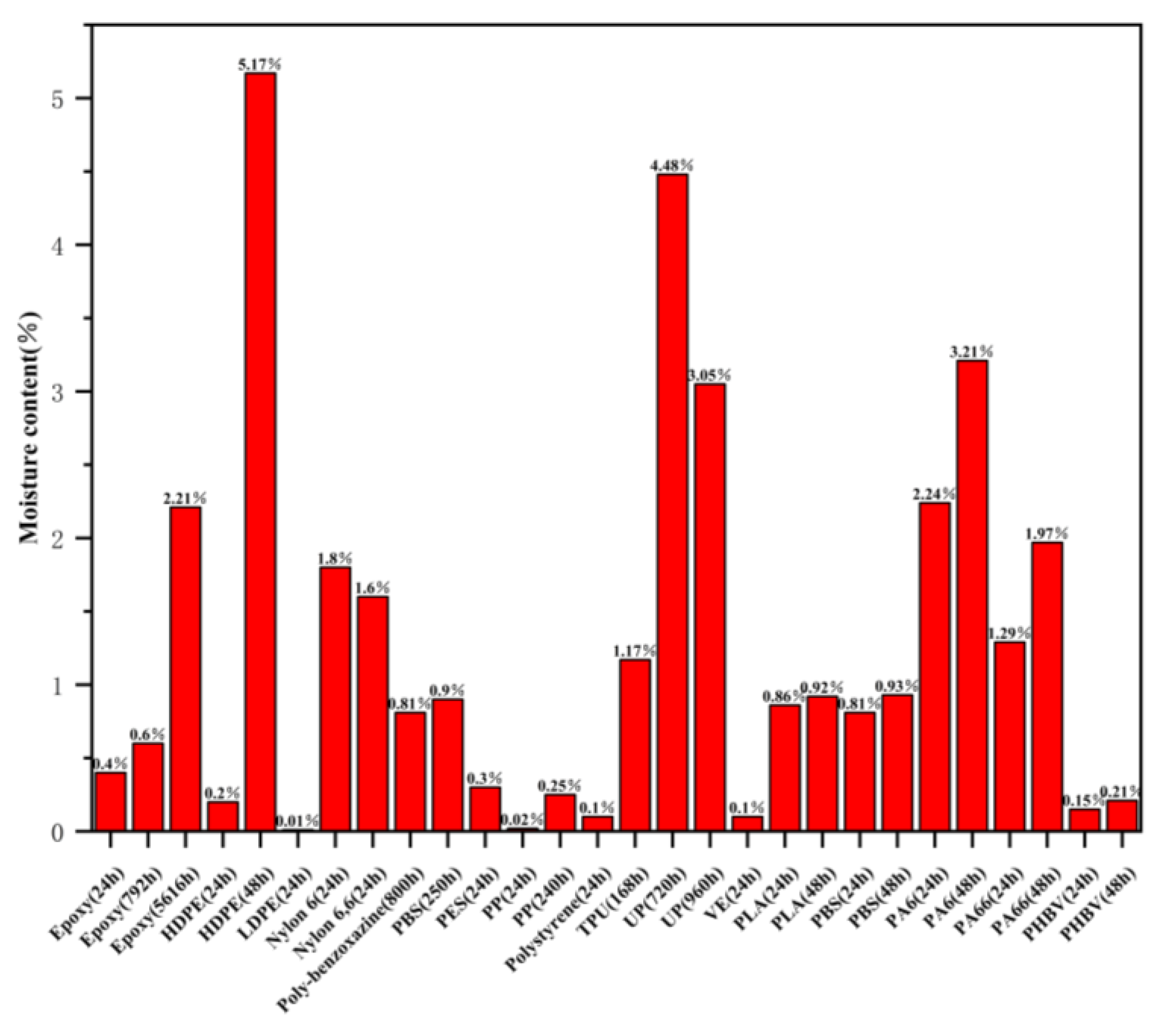


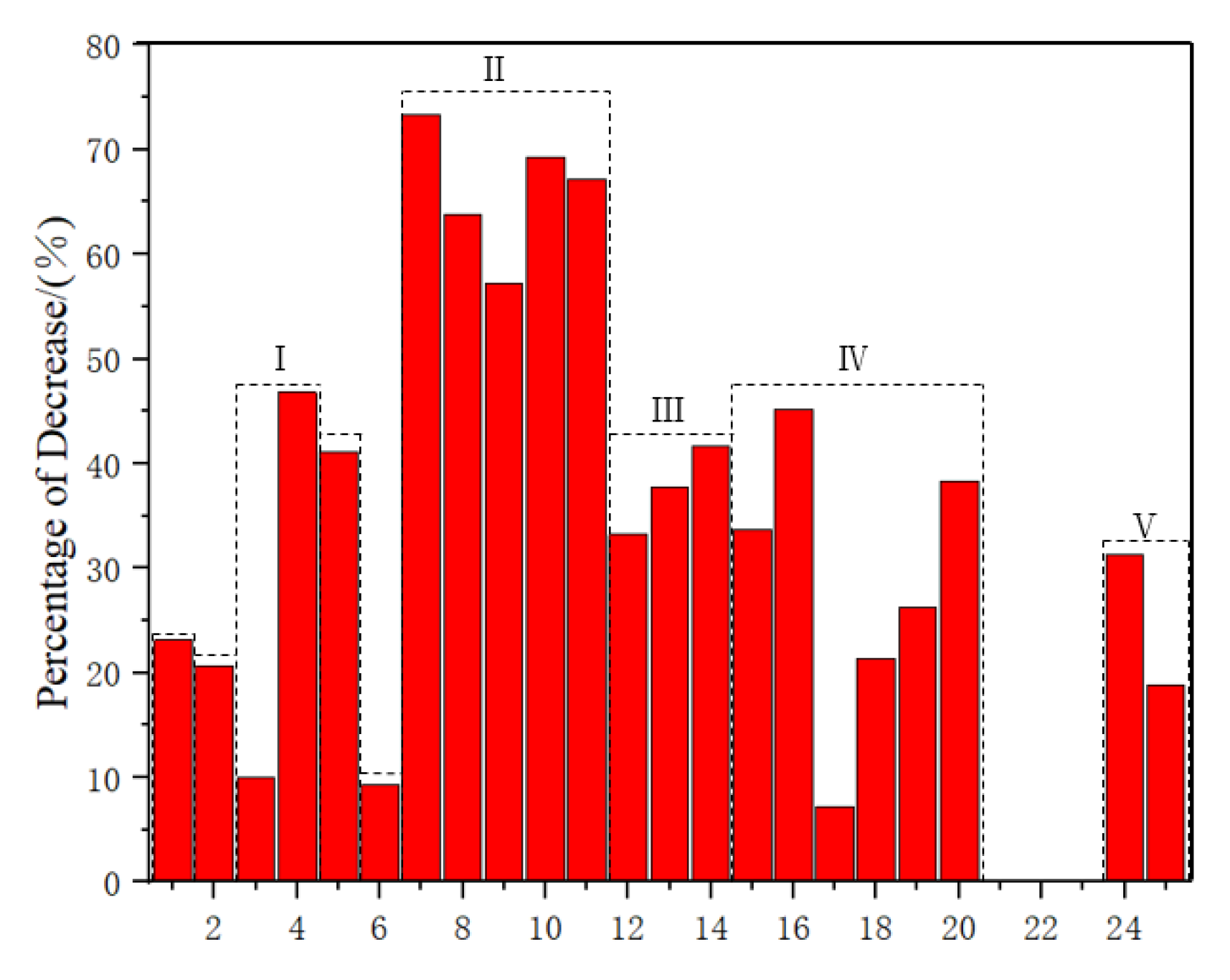
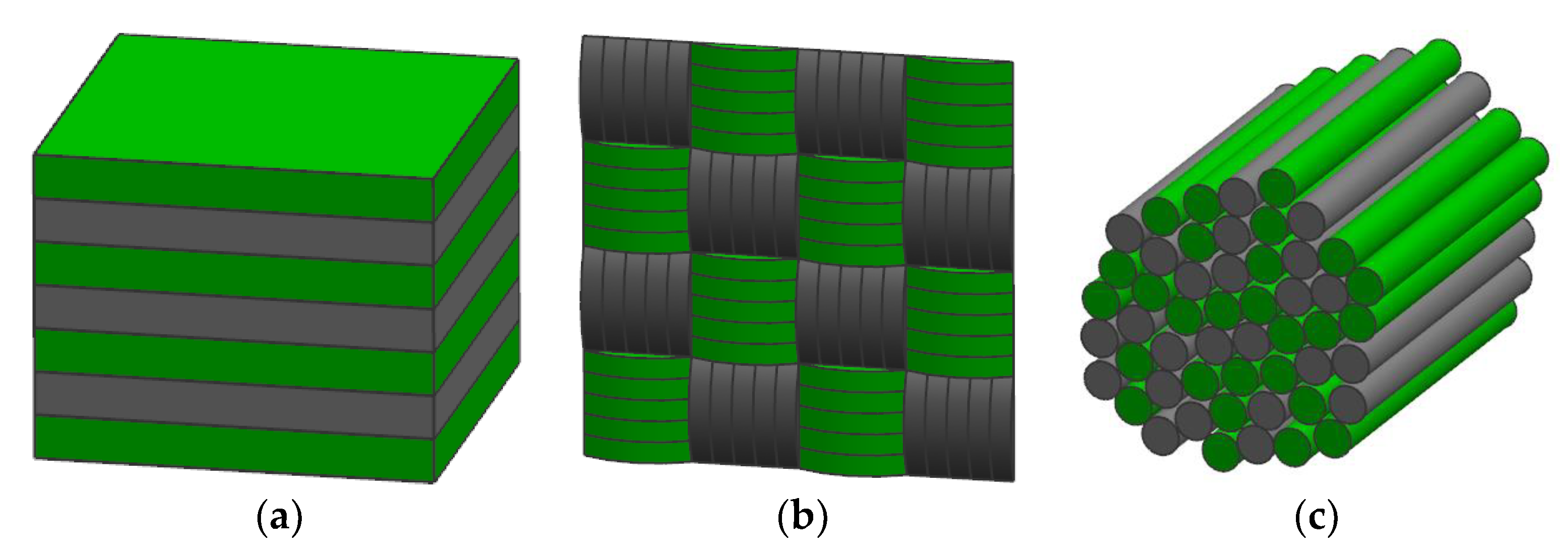
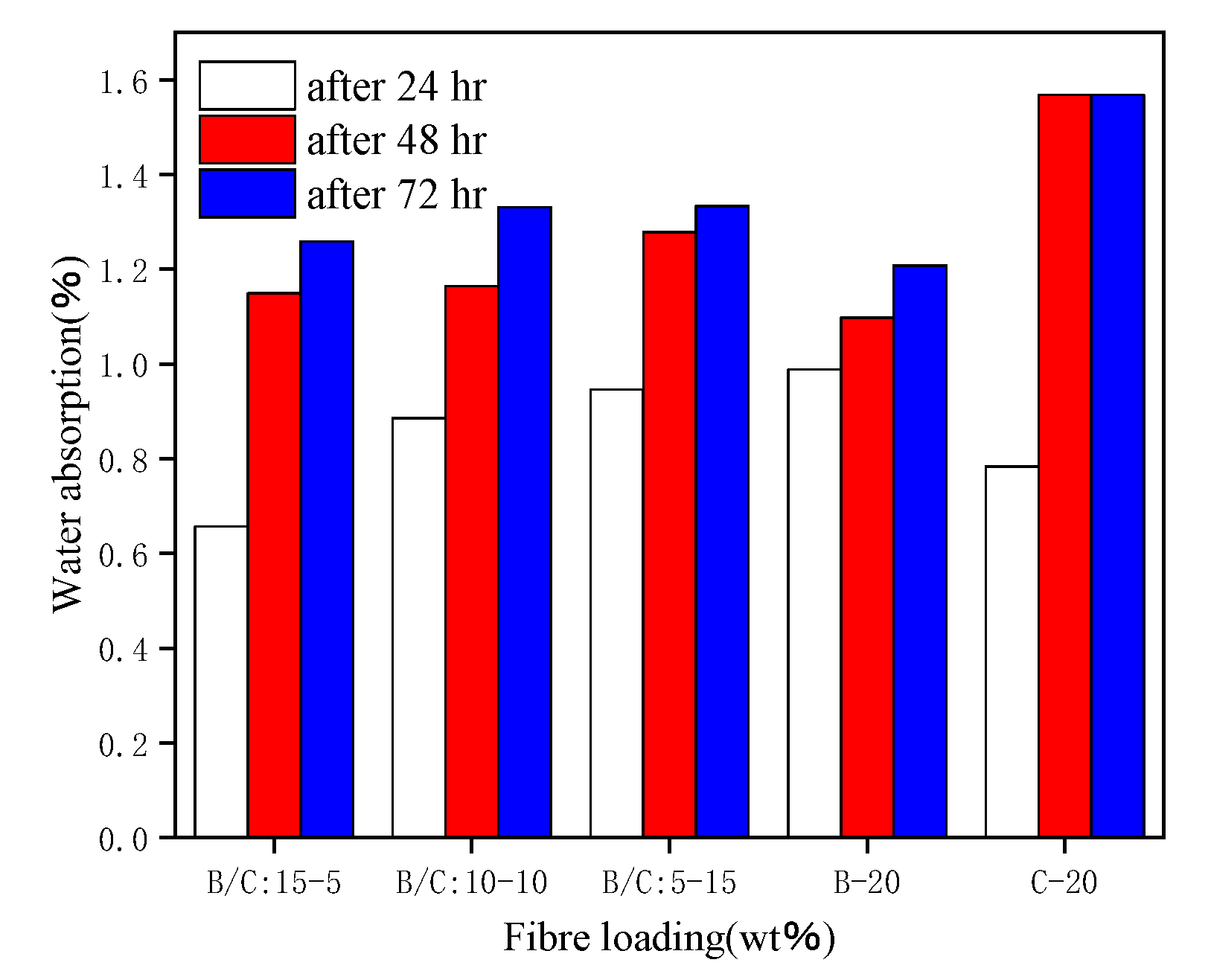

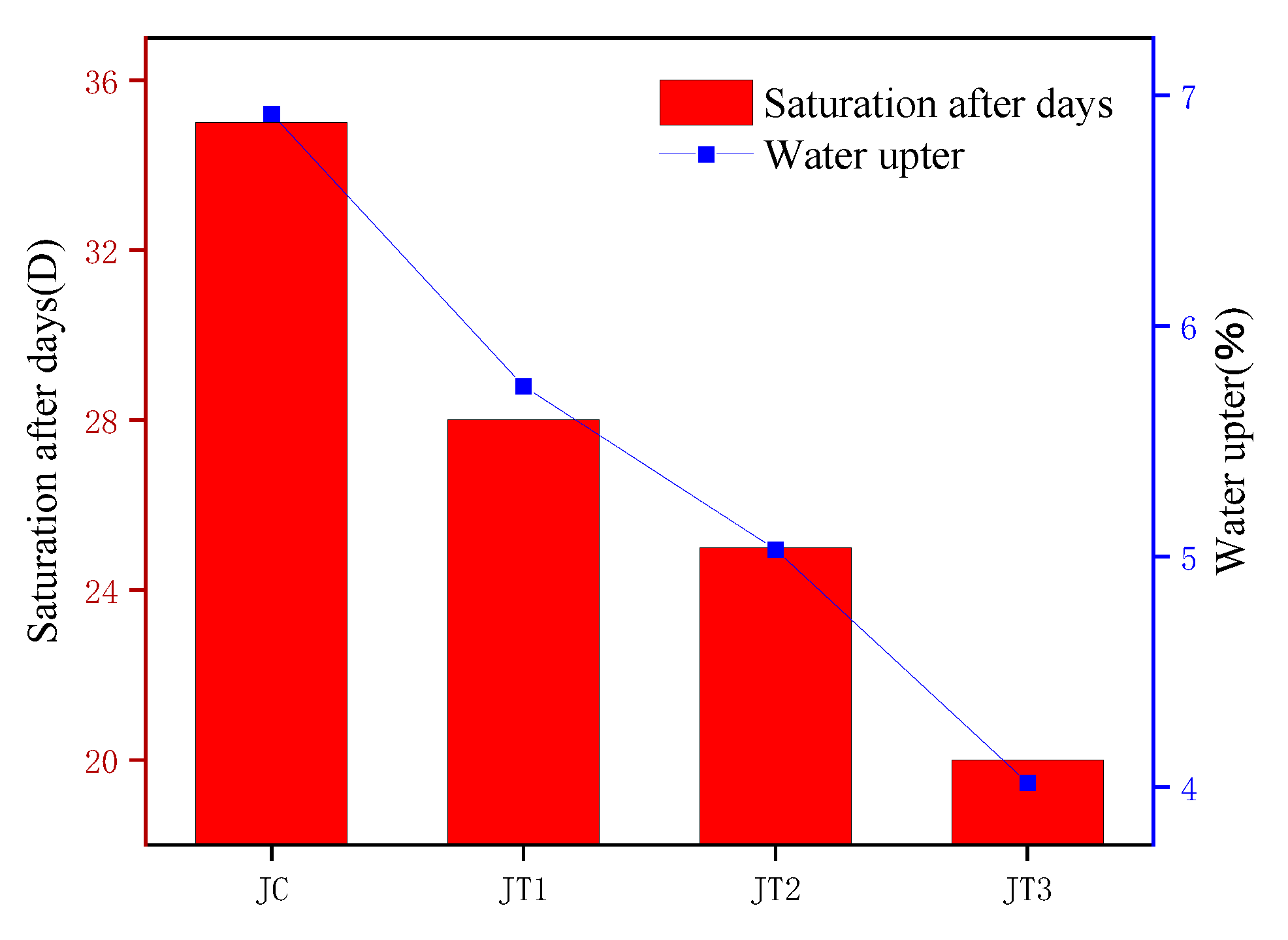
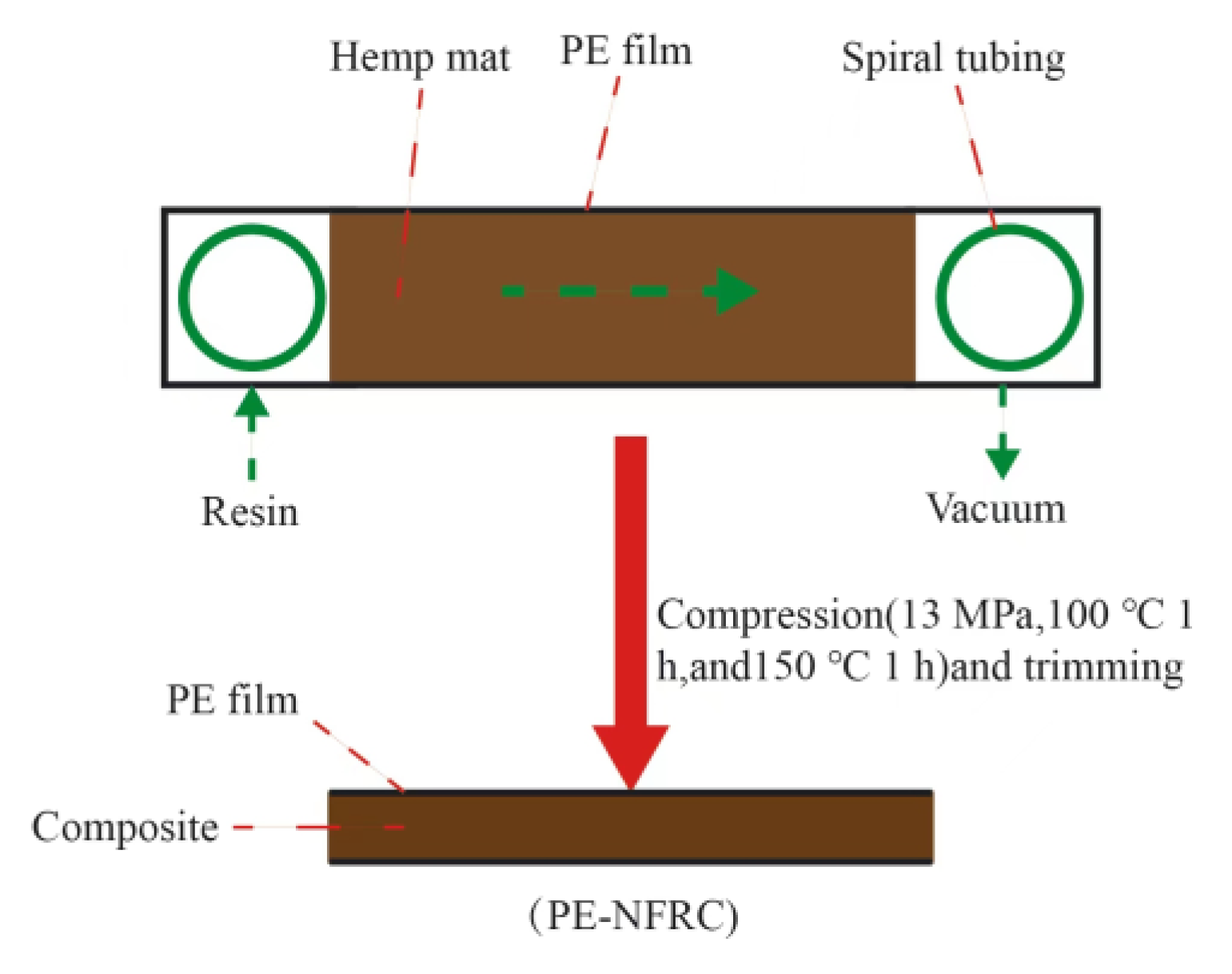
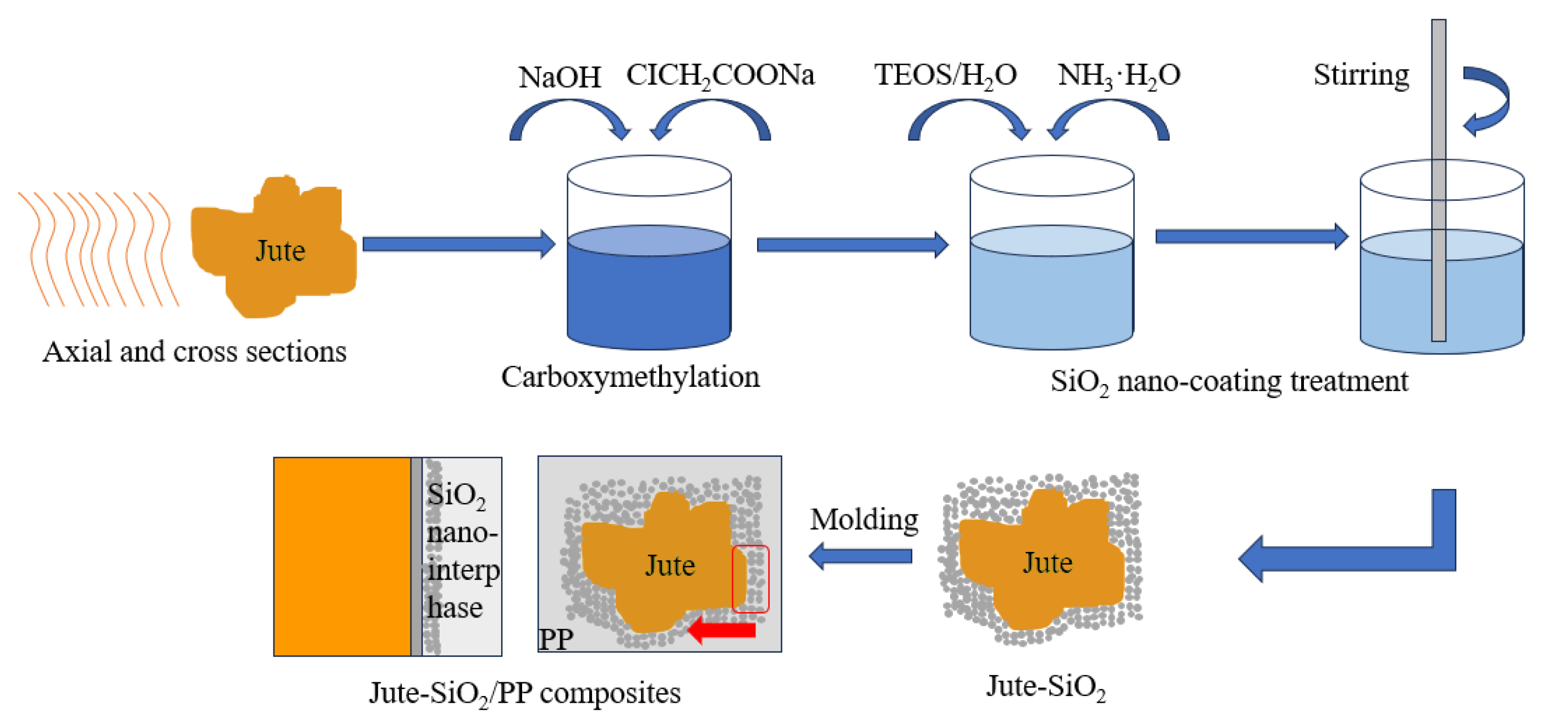
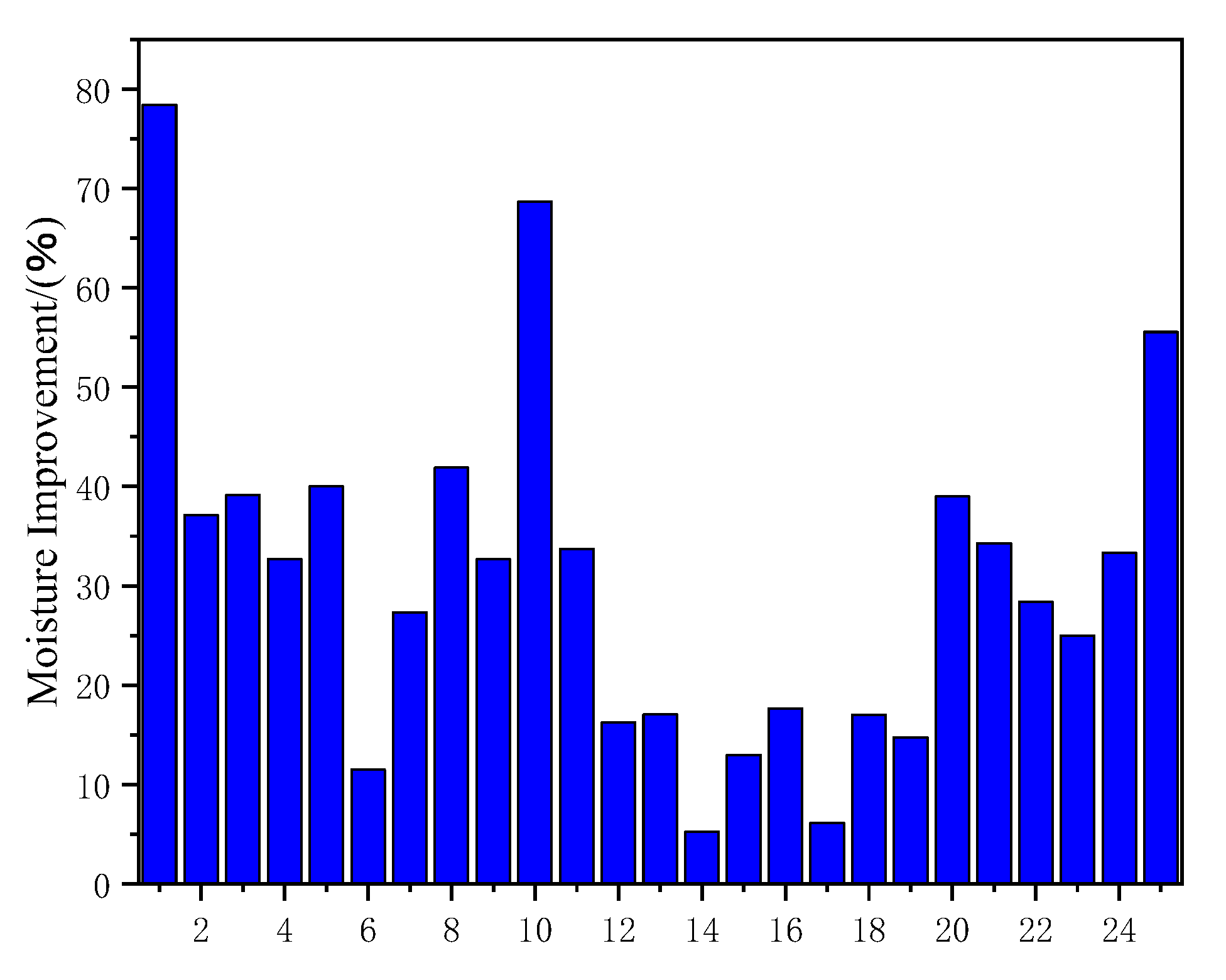
| Diffusion Type | Diffusion Index (n) | Time | Mechanization | |
|---|---|---|---|---|
| Case1 | Less Fickian | n < 0.5 | Rate of diffusion of water molecules is much less than that of polymer segment mobility | |
| Fickian Diffusion | n = 0.5 | |||
| Case2 | Case2 Diffusion | n = 1.0 | (time independent) | Diffusion process is much more active than relaxation processes |
| Super Case2 Diffusion | n > 1.0 | |||
| Case3 | Non-Fickian/ Anomalous Diffusion | 0.5 < n < 1.0 | Mobility of water molecules is comparable to that of polymer segment mobility; It is an intermediary performance between Case1 and Case2 diffusion | |
| Fiber | Water Absorption Saturation Rate/% |
|---|---|
| Flax | 7 |
| Hemp | 7 |
| Abaca | 7 |
| Agave | 8 |
| Sisal | 7 |
| Number | Composite | Note | Tensile Strength (MPa) | Decline Rate | Bending Strength (MPa) | Decline Rate | References | ||
|---|---|---|---|---|---|---|---|---|---|
| Before Absorbing Water | After Absorbing Water | Before Absorbing Water | After Absorbing Water | ||||||
| 1 | Waste Paper/Polyester | 70.2 | 50 | 28.77% | 96.76 | 74.41 | 23.10% | [42] | |
| 2 | Sisal/Epoxy | 20.06 | 17.51 | 12.72% | 53.26 | 42.3 | 20.58% | [18] | |
| 3 | Pennisetum/ | 21–131 | 11–120.52 | 8–47.62% | 47–125 | 25–112.5 | 10–46.81% | [43] | |
| 4 | Glass–Epoxy | ||||||||
| 5 | Cotton fabric/ | - | - | - | 15.8 | 9.3 | 41.14% | [44] | |
| Geopolymer | |||||||||
| 6 | Stem banana Polypropylene | 38.55 | 24.91 | 35.38% | 55.59 | 50.44 | 9.26% | [45] | |
| 7 | Kenaf/Jute/ | K/epoxy | 80 | 20 | 75% | 77.6 | 20.7 | 73.32% | [36] |
| Hemp–Epoxy | |||||||||
| 8 | J/epoxy | 77 | 24 | 68.83% | 68.5 | 24.8 | 63.80% | ||
| 9 | H/epoxy | 76 | 25 | 67.11% | 68.2 | 29.2 | 57.18% | ||
| 10 | K/J/epoxy | 89 | 25 | 71.91% | 95 | 29.2 | 69.26% | ||
| 11 | K/H/epoxy | 83 | 26 | 68.67% | 90.8 | 29.8 | 67.18% | ||
| 12 | Sisal/Epoxy | 26.49 | 23.13 | 12.70% | 60.5 | 35.3 | 33.18% | [19] | |
| 13 | NaHCO3 | 27.1 | 25.55 | 5.70% | 67.6 | 42.14 | 37.67% | ||
| 14 | NaHCO3/PLA coating | 35.5 | 34.23 | 3.56% | 71.5 | 47.77 | 41.65% | ||
| 15 | Jute/Hemp/ | J/epoxy | 43.32 | 25.9 | 40.21% | 59.47 | 39.44 | 33.68% | [46] |
| Flax–Epoxy | |||||||||
| 16 | H/epoxy | 36.68 | 28.2 | 23.12% | 85.59 | 46.92 | 45.18% | ||
| 17 | F/epoxy | 46.21 | 41 | 11.27% | 81.1 | 75.21 | 7.26% | ||
| 18 | J/H/epoxy | 42.19 | 22.4 | 46.90% | 86.6 | 68.11 | 21.35% | ||
| 19 | H/F/epoxy | 44.17 | 26.1 | 40.91% | 44.6 | 32.89 | 26.26% | ||
| 20 | J/H/F/epoxy | 58.59 | 42.3 | 27.80% | 66.6 | 41.1 | 38.29% | ||
| 21 | Sisal/Epoxy | 45 | 38 | 15.56% | - | - | - | [29] | |
| 22 | nanoclay | 57 | 49 | 14.04% | - | - | - | ||
| 23 | microclay | 49 | 42 | 14.29% | - | - | - | ||
| 24 | Jute/Glass | J/polyester | 135.53 | 62.02 | 54.24% | 115.61 | 79.38 | 31.34% | [12] |
| –Polyester | |||||||||
| 25 | J/G/polyester | 261.22 | 152.4 | 41.66% | 366.38 | 297.54 | 18.79% | ||
| Composite (mol%) | Temperature (°C) | Adsorption Coefficient (Q∞) | Composite (mol%) | Temperature (°C) | Adsorption Coefficient (Q∞) |
|---|---|---|---|---|---|
| R40 | 30 | 0.6409 | RB40 | 30 | 0.2329 |
| 60 | 0.8390 | 60 | 0.2429 | ||
| 90 | 0.8080 | 90 | 0.3263 | ||
| RN40 | 30 | 0.3124 | RP40 | 30 | 0.3433 |
| 60 | 0.3283 | 60 | 0.3856 | ||
| 90 | 0.4068 | 90 | 0.4236 | ||
| RH40 | 30 | 0.4931 | RS40 | 30 | 0.3526 |
| 60 | 0.5762 | 60 | 0.3829 | ||
| 90 | 0.6352 | 90 | 0.4009 |
| Properties | Specimens | |||||
|---|---|---|---|---|---|---|
| KK | JJ | HH | KJ | KH | ||
| Tensile strength (MPa) | Dry | 80 ± 4 | 77 ± 3 | 76 ± 5 | 89 ± 3 | 83 ± 1 |
| Saturated | 20 ± 4 | 24 ± 1 | 25 ± 3 | 25 ± 2 | 26 ± 1 | |
| Flexural strength (MPa) | Dry | 77.6 ± 2.9 | 68.5 ± 5.3 | 68.2 ± 4.9 | 95 ± 3.4 | 90.8 ± 6.3 |
| Saturated | 20.7 ± 3.6 | 24.8 ± 3.8 | 29.9 ± 2.3 | 29.2 ± 5.1 | 29.8 ± 2.7 | |
| Moisture absorption rate (%) | 14.1 | 13.9 | 12.1 | 7.5 | 5.1 | |
| Sample Name | Fiber Orientation | Water Absorption (%) | ||||
|---|---|---|---|---|---|---|
| 24 | 96 | 120 | 168 | 192 | ||
| C1 | JJJJJ | 7.43 | 7.5 | 7.7 | 7.7 | 7.7 |
| C2 | JJGJJ | 6.26 | 6.6 | 6.7 | 6.8 | 6.8 |
| C3 | JGJGJ | 5.58 | 5.7 | 5.8 | 5.8 | 5.8 |
| C4 | GJGJG | 4.41 | 4.9 | 5 | 5 | 5 |
| C5 | GGJGG | 3.39 | 3.7 | 3.8 | 3.8 | 3.8 |
| C6 | GGGGG | 2.1 | 2.3 | 2.4 | 2.4 | 2.4 |
| Sample Name | Fiber Orientation | Tensile Strength (MPa) | Flexural Strength (MPa) | Hardness HV |
|---|---|---|---|---|
| C1 | JJJJJ | 38.6875 | 54.71 | 13 |
| C2 | JJGJJ | 59.375 | 80.4 | 20.8 |
| C3 | JGJGJ | 64.025 | 85.5 | 27.7 |
| C4 | GJGJG | 104.625 | 134.65 | 32.2 |
| C5 | GGJGG | 92.1 | 125.95 | 34.5 |
| C6 | GGGGG | 106.8 | 176.8 | 39.9 |
| Composite | Fiber Treatment | Water Absorption Rate | Rising Rate | References | ||
|---|---|---|---|---|---|---|
| Untreated | After Treatment | |||||
| 1 | Pennisetum purpureum /Glass-Epoxy | - | 7.00% | 1.51% | 78.43% | [43] |
| 2 | Hemp/Glass-Polypropylene | - | 8.73% | 5.49% | 37.11% | [74] |
| 3 | Coir/Glass-Polyester | - | 8.53% | 5.19% | 39.16% | [75] |
| 4 | Wood/Hemp-Polypropylene | - | 26.00% | 17.50% | 32.69% | [64] |
| 5 | Jute/Palm-Recycled Polypropylene | - | 1.25% | 0.75% | 40.00% | [59] |
| 6 | Banana/Sisal-Epoxy | - | 21.25% | 18.81% | 11.48% | [29] |
| 7 | Jute-Polyester | PLA coating | 6.92% | 5.03% | 27.31% | [10] |
| 8 | Jute-Polyester | alkali treatment/PLA coating | 6.92% | 4.02% | 41.91% | [10] |
| 9 | Sisal-Polyester | PLA coating | 5.66% | 3.80% | 32.68% | [76] |
| 10 | Hemp-Polyethylene | PE flim | 33.20% | 10.40% | 68.67% | [9] |
| 11 | Jute-Polylactic acid | PP coating | 17.50% | 11.60% | 33.71% | [40] |
| 12 | Sisal-Polyester | NaOH treatment | 5.66% | 4.74% | 16.25% | [9] |
| 13 | Jute-Polyester | alkali treatment | 6.92% | 5.74% | 17.05% | [77] |
| 14 | Kenaf-Polypropylene | NaOH/KMno4 | 21.51% | 16.27% | 5.24% | [40] |
| 15 | Rice husk-Polypropylene | PP-g-MA | 11.39% | 9.91% | 12.99% | [50] |
| 16 | PP-g-MA/SEBS-g-MA | - | 9.38% | 17.65% | ||
| 17 | Silane | - | 10.69% | 6.15% | ||
| 18 | Silane/PP-g-MA | - | 9.45% | 17.03% | ||
| 19 | Silane/PP-g-MA/SEBS-g-MA | - | 9.71% | 14.75% | ||
| 20 | Luffa fibre /Polypropylene | (3-Aminopropyl) triethoxysilane (AS) | 2.80% | 1.71% | 39.00% | [73] |
| 21 | 3-(Trimethoxysilyl)-1-propanethiol (MS) | - | 1.84% | 34.30% | ||
| 22 | Maleic anhydride grafted PP (MAPP) | - | 2.00% | 28.40% | ||
| 23 | Rice husk /Polypropylene | PP-g-MAH | 0.36% | 0.27% | 25.00% | [72] |
| 24 | MMT | - | 0.24% | 33.33% | ||
| 25 | PP-g-MAH/MMT | - | 0.16% | 55.55% | ||
Disclaimer/Publisher’s Note: The statements, opinions and data contained in all publications are solely those of the individual author(s) and contributor(s) and not of MDPI and/or the editor(s). MDPI and/or the editor(s) disclaim responsibility for any injury to people or property resulting from any ideas, methods, instructions or products referred to in the content. |
© 2023 by the authors. Licensee MDPI, Basel, Switzerland. This article is an open access article distributed under the terms and conditions of the Creative Commons Attribution (CC BY) license (https://creativecommons.org/licenses/by/4.0/).
Share and Cite
Wang, Q.; Chen, T.; Wang, X.; Zheng, Y.; Zheng, J.; Song, G.; Liu, S. Recent Progress on Moisture Absorption Aging of Plant Fiber Reinforced Polymer Composites. Polymers 2023, 15, 4121. https://doi.org/10.3390/polym15204121
Wang Q, Chen T, Wang X, Zheng Y, Zheng J, Song G, Liu S. Recent Progress on Moisture Absorption Aging of Plant Fiber Reinforced Polymer Composites. Polymers. 2023; 15(20):4121. https://doi.org/10.3390/polym15204121
Chicago/Turabian StyleWang, Quan, Tuo Chen, Xiaodong Wang, Yue Zheng, Jiayu Zheng, Gaojie Song, and Shuyi Liu. 2023. "Recent Progress on Moisture Absorption Aging of Plant Fiber Reinforced Polymer Composites" Polymers 15, no. 20: 4121. https://doi.org/10.3390/polym15204121





